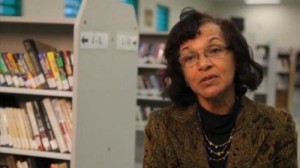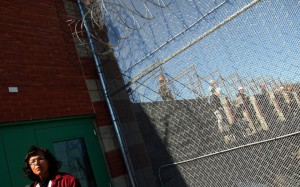Em final de março, mais precisamente no dia 26, saiu uma matéria no The Washington Post, que obviamente me chamou a atenção. A manchete dizia “A believer in books behind bars”. A matéria, que ocupou meia página de jornal de sábado, tratou de um assunto que, pelo senso comum, deveria ser óbvio, mas, no entanto, passa longe de ser: a educação pode mudar vidas (para melhor!).
O artigo contava a história de Glennor Shirley, bibliotecária-chefe das prisões de Maryland, e a sua batalha para continuar com os programas de incentivo à leitura dentro dos estabelecimentos penais de sua responsabilidade, apesar de cortes orçamentários.
Miss Shirley, como é chamada pelos frequentadores das bibliotecas, é perseverante e diz acreditar na justiça e no que é correto. Ela afirma ter percebido essa necessidade no mundo atrás das grades e por esta razão não mede esforços para continuar com os seus programas de incentivo à leitura.
Por conta dos cortes orçamentários, o seu trabalho tem sido mais estressante e complexo, o que não a impede de continuar buscando apoio para que as bibliotecas nas prisões não caiam no sucateamento, como tantas outras coisas no sistema de execução penal. Ela conta basicamente com a ajuda de doações.
Como a maioria das pessoas já sabem, quando se chega no inevitável momento de bifurcação em que se deve escolher entre a punição ou a reabilitação do preso, o pêndulo sempre se volta para a primeira opção. A pergunta é sempre a mesma: “por que deveríamos priorizar o bem estar do bandido ou criminoso atrás das grades em detrimento do cidadão honesto?”
O que, na maioria das vezes, se esquece é que, principalmente no Brasil, onde não existe pena de morte ou de prisão perpétua, esses “bandidos ou criminosos atrás das grades” fatalmente voltarão às ruas. E, nesse caso, se puderem voltar com alguma educação a mais ou alguma perspectiva de futuro, certamente oferecerão bem menos perigo para a sociedade. Aliás, nos Estados Unidos, onde estudos de criminologia são feitos com maior regularidade, pesquisas apontam que programas educacionais em prisões podem refletir em uma diminuição de 29% nas taxas de reincidência, número bastante considerável.
Importante notar que algo que eu sempre frisei em meus textos, aulas e palestras ficou evidenciado nesse artigo: que presos que se envolvem com algum tipo de atividade que os ocupem e/ou os distraiam geralmente são mais calmos e concentrados, o que evita problemas maiores como tentativas de fugas, depredação e vandalismo ou rebeliões.
Por esta razão é que, sempre quando sou consultada em relação a projetos arquitetônicos de estabelecimentos penais, eu sempre gosto de ressaltar a importância de se planejar espaços e ambientes para que atividades educacionais, profissionalizantes e/ou esportivas sejam desenvolvidas. Não se trata tão somente de proporcionar uma vida mais digna ao preso, mas também de construir a base para um futuro melhor, como egresso de volta à sociedade.
Saiba mais sobre Glennor Shirley, lendo o seu blog “Prison Librarian“.
Leia a matéria na íntegra a seguir:
By Michael S. Rosenwald in CUMBERLAND, Md.
The library is quiet. At the front counter, workers shuffle papers, sort books and peck at computers. A woman walks in. “Oh, Miss Shirley is here,’’ says the man behind the library reference desk, peeking over the top of his reading glasses. He is a convicted murderer.
Miss Shirley is Glennor Shirley, head librarian for Maryland prisons, responsible for the rows of books behind the barbed-wire fences here at Western Correctional Institution and 16 other state prison libraries. The inmate behind the desk and librarian’s relationship dates back to a Commodore 64.
“Remember when you locked me in a room until I learned how to use that computer?’’ says the inmate, who wasn’t authorized by the prison to be quoted by name. Miss Shirley laughs, changes the subject, deflecting attention from herself, and then the inmate whispers: “Don’t let her be too modest. She is an amazing teacher. A lot of us have relied on her.’’
Murderers, rapists, thieves, and drug dealers have been relying on Miss Shirley, as she is always called by library visitors, for more than two decades to get them Jackie Collins novels, Westerns, biographies of Henry Ford, the latest James Patterson page-turner, poetry, Entrepreneur magazine, math textbooks, resume guides, and illustrated books about snakes.
But with state budget shortfalls, Miss Shirley is no longer allocated money for new books. Her already tiny slice of the $13.9 million prison education budget was whittled back even further after the department took a $2.1 million hit last year. Staffing is down. Funds for programs letting prisoners read books to their children — also gone.
These days, her stories about library science behind bars often begin with this phrase, “When I had money … ’’
Miss Shirley has weathered deficits during previous recessions as lawmakers diverted money away from prisoners toward law-abiding citizens — a constituency, she knows, that is prone to ask, “Why give money to murderers to read when people can’t get jobs?’’
The pendulum between punishment and rehabilitation behind bars always swing toward punishment during tough fiscal times, prisoner advocates say. But they also argue the swing is short-sighted, pointing to studies showing education programs can reduce recidivism by 29 percent.
“Libraries in prisons change lives,’’ says Diana Reese, president of the American Library Association’s division for specialized libraries.
Prisoners acknowledge the difficult decisions lawmakers face.
“Here are these men locked up, promised three meals a day, and we can read at our leisure without paying the rent,’’ says Wayde Heslop, 38, of Silver Spring, who is serving a life sentence at North Branch Correctional for the murder of a 23-year-old Hyattsville man. (Heslop loved “The Count of Monte Cristo.’’). “But some of these men are coming back home. If they come into society, at least they should come back educated.”
Miss Shirley is not complaining. Rather, she has won plaudits from her prison librarian peers for pushing ahead despite setbacks facing the entire prison reading community. “Her libraries have been devastated in the last few years,” says Diane Walden, Miss Shirley’s counterpart for Colorado’s prisons. “She doesn’t complain or vent or whine. She is very focused on what she can do. She’s an amazing person and advocate.”
Miss Shirley, 67, immigrated to Maryland in 1980s from Jamaica, where she was a librarian. She has a gentle voice, inflected with an island accent, and she’s a talker. While working low-level jobs in public libraries during the day, she worked nights in a prison library to pay her bills.
“I was just being practical,” she says. “I needed the money.” She remembers the first time the gate clanged behind her. “I had hundreds of inmates in my face. It was a strange feeling, these dozens of eyes looking at you and assessing you.”
The part-time job turned full time, and Miss Shirley rose to become a nationally known advocate for prison reading, telling tales of life behind bars in popular blog, Prison Librarian. About a program she organized for prisoners to read to their children, she quotes an inmate saying, “It couldn’t get any righter than this.”
“I am basically a person who believes in justice and what is right,” Miss Shirley says. “I saw these needs behind the bars.”
With the state facing a $1.6 billion budget shortfall, her job has become stressful and more complex. Miss Shirley relies on donations to line the shelves, but many books are several years out of date or the pages are too weathered or brown to be used.
Miss Shirley, whose official title is library coordinator, is not above mining connections to score good books for her staff of librarians. She is president of the Maryland Library Association, and she seeks appointments to organizations that she can lean on for help. “I run my mouth a lot,” she says.
She ran it last year with the One Maryland One Book program, landing copies of “Outcasts United” for prisoners, who then discussed the book at a meeting with author Warren St. John. “I didn’t get down on my hands and knees and beg,” Miss Shirley says, “but I did charm them.”
Roughly 7,000 new prisoners sign up for library privileges every year, according to state statistics. There are about 199,000 items in monthly circulation. The libraries look little different than an elementary school’s facility. The shelves are low. The Dewey Decimal System is in operation. Posters for the National Book Festival hang on the wall, even though these library patrons won’t attend.
Miss Shirley has found that leisure reading among prisoners – when they aren’t doing legal research – has held relatively steady. Urban novels are popular. So are romance novels by Jackie Collins and Eric Jerome Dickey. “A lot of guys in relationships, they read that stuff to tap their sensitive aspects”, says Heslop, the inmate from Silver Spring.
Westerns are popular for their depiction of old-time lawlessness. Thrillers are also in high demand.
“It’s like people reading Dean Koontz on a plane,” says Larry Sullivan, a John Jay College of Criminal Justice professor and expert on prison reading. “It’s easy. It’s like candy. But reading almost anything is better than reading nothing. You’d rather have someone reading a novel than hanging around the yard stabbing someone.”
Miss Shirley says library users tend to be better behaved and more focused on their future, even if, like Heslop, they will likely spend the rest of their lives behind bars. His favorite magazine: Entrepreneur. “You might read a story in there os a person being poor, sleeping on the street, but they had an education and they knew where to go to elevate themselves,” he says. “It’s very encouraging.”
“Prisoners”, he says, “look forward to library visits. If a guard yells ‘library day’ in the cellblocks, he says, inmates pipe up and bang on their doors: Cell 45! Cell 42! Everyone wants to come. It’s like you are not even in prison anymore. You feel like you are uptown in the library. There are no bars in here.”
Imagens e texto retirados do The Washington Post, de 26 de março de 2011.
Post escrito na vigência da Bolsa de Estágio de Doutorado – Balcão concedido pela CAPES, desenvolvido na Pennsylvania State University, em State College, PA, Estados Unidos.


